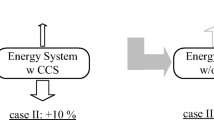Abstract
If substantial amounts of CO2, which according to actual scenarios may in the future be captured from industrial processes and power generation, shall be utilized effectively, scalable energy efficient technologies will be required. Thus, a survey was performed to assess a large variety of applications utilizing CO2 chemically (e.g., production of synthesis-gas, methanol synthesis), biologically (e.g., CO2 as fertilizer in green houses, production of algae), or physically (enhancement of fossil fuel recovery, use as refrigerant). For each of the processes, material and energy balances were set up. Starting with pure CO2 at standard conditions, expenditure for transport and further process specific treatment were included. Based on these calculations, the avoidance of greenhouse gas emissions by applying the discussed technologies was evaluated. Based on the currently available technologies, applications for enhanced fossil fuel recovery turn out to be most attractive regarding the potential of utilizing large quantities of CO2 (total capacity > 1000 Gt CO2) and producing significant amounts of marketable products on one hand and having good energy and material balances on the other hand \( \left( {{{t_{CO_2 - emitted} } \mathord{\left/ {\vphantom {{t_{CO_2 - emitted} } {t_{CO_2 - utilized} < 0.2 - 0.4}}} \right. \kern-\nulldelimiterspace} {t_{CO_2 - utilized} < 0.2 - 0.4}}} \right) \). Nevertheless, large scale chemical fixation of CO2 providing valuable products like fuels is worth considering, if carbon-free energy sources are used to provide the process energy and H2 being essential as a reactant in a lot of chemical processes (e.g., production of DME: \( {{t_{CO_2 - emitted} } \mathord{\left/ {\vphantom {{t_{CO_2 - emitted} } {t_{CO_2 - utilized} > 0.34}}} \right. \kern-\nulldelimiterspace} {t_{CO_2 - utilized} > 0.34}} \)). Biological processes such as CO2 fixation using micro-algae look attractive as long as energy and CO2 balance are considered. However, the development of effective photo-bioreactors for growing algae with low requirements for footprint area is a challenge.
Similar content being viewed by others
References
Aresta. Michele: Carbon Dioxid Recovery and Utilization. Norwell: Kluwer Academic Publishers, 2003
Schmidt V M. Elektrochemische Verfahrenstechnik. Weinheim: WILEY-VCH Verlag GmbH & Co. KGaA, 2003
Song C, Pan W. Tri-reforming of methane: a novel concept for catalytic production of industrially useful synthesis-gas with desired H2/CO ratios. Catalysis Today, 2004, 98: 463–484
Tsubaki N, Ito M, Fujimoto K. A new method of low-temperature methanol synthesis. Journal of Catalysis, 2001, 197: 224–227
Olah G A, Goeppert A, Prakash G K S. Beyond Oil and Gas: The Methanol Economy. Weinheim: WILEY-VCH Verlag GmbH & Co. KGaA, 2006
Arakawa H, Dubois J L, Sayama K. Selective conversion of CO2 to methanol by catalytic hydrogenation over promoted copper catalyst. Energy Convers Mgmt, 1992, 33: 521–528
Ree M, Hwang Y, Kim J S, Kim H, Kim G, Kim H. New findings in the catalytic activity of zinc glutarate and its application in the chemical fixiation of CO2 into polycarbonates and their derivatives. Catalysis Today, 2006, 115: 134–145
Koinuma H. Oxide materials research for global environment and energy with a focus on CO2 fixation into polycarbonates and their derivates. Catalysis Today, 2007, 115: 1129–1136
De Lijser H. Gas for the greenhouse. Nature, 2006, 442(7102), 442–499
Grünberg F. Treibhausgas aus der Pipeline, in Linde Technology-Berichte aus Technik und Wissenschaft Januar 2006, 40 ff
Gentzis T. Subsurface sequestration of carbon dioxide— an overview from an Alberta (Canada) perspective. International Journal Of Coal Geology, 2000, 43: 287–305
Wildenborg T, Lokhorst A. Introduction on CO2 geological storage: classification of storage options. Oil & Gas Science and Technology, 2005, 60: 513–515
Bondor P L. Applications of carbon dioxide in enhanced oil recovery. Energy Conversion & Management, 1992, 33: 579–586
Gozalpour F, Ren S R, Tohidi B. CO2 EOR and storage in oil reservoirs. Oil & Gas Science and Technology, 2005, 60: 537–546
Oldenburg C M, Stevens S H, Benson S M. Economic feasibility of carbon sequestration with enhanced gas recovery. Energy, 2004, 29: 1413–1422
Blok K, Williams R H, Katofsky R E, Hendriks C A. Hydrogen production from natural gas, sequestration of recovered CO2: in depleted gas wells and enhanced natural gas recovery. Energy, 1996, 22: 161–168
Zhang Z X, Wang G X, Massarotto P, Rudolph V. Optimization of pipeline transport for CO2 sequestration. Energy Conversion & Management, 2006, 47: 702–715
Shi J Q, Durucan S. CO2 storage in deep unminable coal seams. Oil & Gas Science and Technology, 2005, 60: 547–558
Hamelinck C N, Faaji A P C, Turkenburg W C, Bergen F van, Pagnier H J M, Barzandji O H M, Wolf K H A A, Ruijg G J. CO2 enhanced coalbed methane production in the Netherlands. Energy, 2002, 27: 647–674
Pearson A. Carbon dioxide— new uses for an old refrigerant. International Journal Of Refrigeration, 2005, 28: 1140–1148
Garimella S. Innovations in energy efficient and environmentally friendly space-conditioning Systems. Energy, 2003, 28: 1593–1614
Asinger F. Methanol, Chemie und Energierohstoff. Berlin (West),: Springer Verlag, 1986
Sun K, Lu W, Wang X M, Xu X M. Low-temperature synthesis of DME from CO2/H2 over Pd-modified CuO-ZnO-Al2O3-ZrO2/HZSM-5 catalysts. Catalysis Communications, 2004, 5: 367–370
Jiang C, Guo Y, Wang C, Wu Y, Wang E. Synthesis of dimethyl carbonate from methanol and carbon dioxide in the presence of polyoxometalates under mild conditions. Applied Catalysis A: General, 2003, 256: 203–212
Dente M, Pierucci S, Sogaro A, Carloni G, Rigolli E. Simulation program for urea plants. Comput Chem Engng, 1988, 12: 389–400
Author information
Authors and Affiliations
Corresponding author
Rights and permissions
About this article
Cite this article
Schaefer, M., Behrendt, F. & Hammer, T. Evaluation of strategies for the subsequent use of CO2 . Front. Chem. Eng. China 4, 172–183 (2010). https://doi.org/10.1007/s11705-009-0236-z
Received:
Accepted:
Published:
Issue Date:
DOI: https://doi.org/10.1007/s11705-009-0236-z



